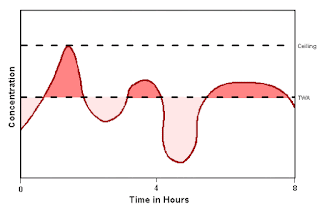Permissible Exposure Limits (PEL's) are actual legal limits determined by OSHA that limit the amount or concentration of exposure to certain chemical substances or physical agents (i.e noise) to employees while working. American Conference of Governmental Industrial Hygienists (ACGIH) as many of the permissible exposure limits that were set into place by OSHA were the actual threshold limit values established by ACGIH.
As mentioned in my previous post, most of the chemical exposures are expressed in parts per million. While OSHA is behind the actual adoption of these regulations I think it is important to give credit to the
Now as I also mentioned in previous posts, there are several ways exposure can be expressed. Be it Short Term Exposure Limits, Ceiling Limits, or what I plan to further discuss, Time-Weighted Averages. A Time-Weighted Average (TWA) is basically the average exposure to any hazardous material that an employee could expect to receive under standard working conditions and considering an 8 hour work day or 40 hours per week work week. Time weighted average allows for peaks and valleys to generate a single average concentration.
The average exposure is compared overtime to the occupational exposure limit to check for excursions. Excursions in exposure levels may exceed 3 times the TWA for no more than a total of 30 minutes during a workday, and for no reason should they ever exceed 5 times the TWA, considering that the TWA is not exceeded. Basically if put simply, a worker can be exposed to higher concentrations so long as it does not exceed a ceiling, the exposure is not occurring for a long period of time, and the number of times that the worker is exposed to that dose of the hazard is kept to a bare minimum.
To calculate the TWA you multiply the concentration (C) by time (T) and then divide by this time.
The goal of having these permissible exposure limits and observing the time weighted averages is to limit the potential for adverse health effects while working on the job. Just to get a glimpse on how these limits are really protecting workers you can look as OSHA's ruling that limits exposure to respirable crystalline silica. OSHA estimates that the rule will save over 600 lives and prevent more
than 900 new cases of silicosis each year, and that's by limiting exposure to merely one substance.


